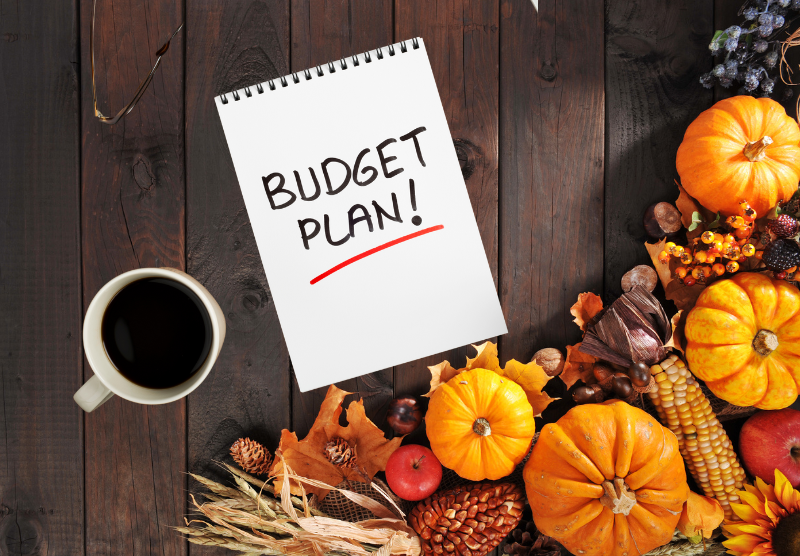
Thanksgiving is a holiday for giving back, spending time with family and being merry. Sounds like a wonderful time. However, it is easy to get carried away and spend way more than necessary. Thanksgiving is an expensive holiday and since inflation is on the rise again, you need to budget wisely and keep costs low. Lucky for you, this article will give you helpful budgeting tips to help you save money and not blow your budget this festive season.
Tip #1: Make A Guestlist
Before you plan a thanksgiving gathering, make sure you know the number of people coming before you hit the grocery store. If you do not know the number of people coming, stick to a smaller guest list. You do not want a scenario where you plan an event but do not accurately know who is coming. As a result, you might spend way more at the grocery store thinking you are making a meal for a large group of people, but in reality, only a few people show up. Now you have wasted food and have spent money on foods that were not necessary. Minimize waste by planning the guest list sooner.
Tip #2: No to impulse buying
Most people, myself included do grocery shopping with no sound plan. When something catches our attention while shopping, We immediately make a beeline for the item and add it to the cart. Sometimes, you were not even planning to purchase these items! This leads to buying things for no reason and incurring extra costs. If it is not planned in your budget ahead of time, it is impulse buying. Before thanksgiving shopping, make sure to have a handy list you can always refer to and cross-check to see if you got the needed meal prep ingredients. You can use the iPhone notes app or any other phone notes app you have for the grocery list to make sure you are always on track. Using the notes app is also convenient, as you can always use the list on the go, instead of using paper lists which may get lost. Also, check out your kitchen pantry to see if you have any ingredients. The last thing you want is to buy new canned cream corn when an unopened can of cream corn is still sitting in your pantry.
Tip #3: Shop smarter not harder
There are a lot of thanksgiving deals that usually go up around that time. Spend more time carefully researching prices at your top three favourite stores a week before thanksgiving or even earlier ( before all the foodstuffs are gone) Do not buy anything because it is cheap. Compare prices between your fave stores on all the necessary items you need to help you prepare for your dinner. Some food items are also seasonal, meaning these food items are cheaper during the Thanksgiving season. For example, turkey, sweet potatoes, pumpkins, brussel sprouts and squash are just a handful of products that are usually affordable during the thanksgiving period. These items can be used to make delicious meals without blowing your budget. Skip out on the out-of-season produce like asparagus or green beans as they will be more expensive during Thanksgiving.
Tip #4: Prepare budget-friendly recipes
Instead of trying to create expensive gourmet meals, you saw on Gordon Ramsay’s website, If you are looking to really cut back on costs, you can make some affordable thanksgiving meals that won’t break the bank. For example a boneless turkey recipe, roasted sweet potatoes with honey and cinnamon, pumpkin rolls, cornbread etc. If you are doing a Friendsgiving, you can make it a potluck by preparing a main dish, and have your friends bring some side dishes or even drinks to help you cut back on additional extra costs. After all, sharing is caring! A potluck also helps you save time because you are just cooking one dish instead of a thanksgiving ideal setup.
Tip #5: Consider using canned or frozen veggies
Canned veggies are considered non-perishable items. These items you can usually buy in bulk at the grocery store. Non-perishable items are usually cheaper than buying fresh market produce. Keep an eye out when shopping for canned items though. Always check the expiry dates and make sure to choose canned veggies that are low or have no sodium. Frozen veggies are also another great option. They are usually packed in a container when they are freshly ripe meaning they have a lot of nutritional benefits and flavour. Plus frozen veggies are also wallet friendly!
Tip #6: Get creative with your leftovers
There is always bound to be a leftover turkey at thanksgiving. Instead of throwing your leftovers away after thanksgiving, Consider using the leftovers to make nutritious meals for later. You can experiment with your leftovers and make a turkey with rice and gravy, turkey wraps, turkey noodle soup, turkey casserole etc Make sure to properly store your leftovers in a freezer or put them in an airtight container or a sealed storage bag in the fridge to retain the freshness of your meal.
It is possible to have a Thanksgiving dinner for your family and friends without going to great lengths and breaking the bank. Using these tips, we hope you would be able to make a DIY thanksgiving dinner that is equally delicious and wallet-friendly for yourself, friends or family. Happy Thanksgiving everyone!